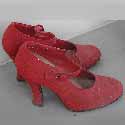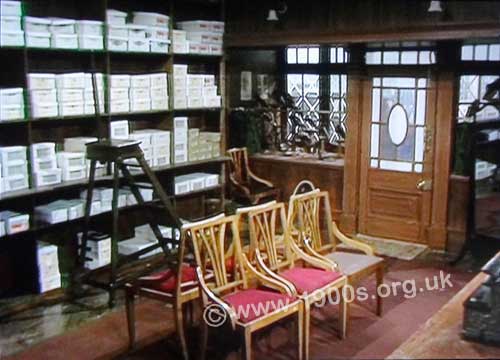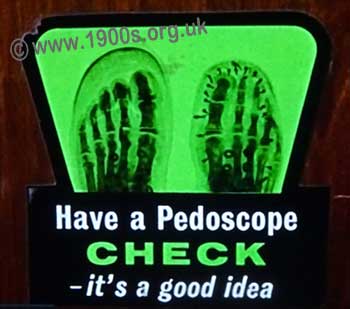Shoe shops in the UK, 1940s wartime into the 1950s

This page is about shoe shops in the UK from 1940s wartime into the 1950s when self-service was unheard of. It describes the shop layout; how shoes were fitted with measurements and an X-ray device to see how feet inside shoes; cheaper and more expensive outlets and makes of shoes.
____
By the webmaster, based childhood observations and discussions with others
The layout arrangement inside shoe shops
Probably the most common shoe shop was Lilley and Skinner because it was a chain store. All its shops had the same layout. There was a double row of chairs down the centre of the shop for customers to sit on, and the walls were lined with boxes of shoes. There was very little in the way of displays, although there were displays in the shop windows.

Inside a typical mid-20th century shoe shop
The procedure for buying shoes
As I remember, we walked in, sat in a chair and waited for an assistant to come up to serve us. We usually had little idea of the details of the shoes that we wanted, only that they were for school or walking or whatever.
Makes of shoes
The shoes could be any one of a number of makes. Particularly well-known were Stead and Simpson, Bata and Clarks. I don't remember any shortages in wartime, but I suppose they must have existed.
How shoes were fitted
Shoes were available in several sizes and half sizes for length and in several widths indicated by letters. The assistant always measured the length of each foot separately using a wooden measure with a sliding attachment and a tape measure for width.
Once she knew the shoe size and the type of shoe required, she climbed up a step-ladder to retrieve a selection of boxes from the packed walls. Self-service was unheard of.
We tried on several pairs and walked up and down in them. If a pair weren't right, the assistant was always at pains to try something different, and we could end up with opened boxes all around us. In view of her efforts, it could be quite embarrassing to admit that none of the shoes felt right and to leave without buying anything.
The X-ray device to check how well shoes fitted
At that time there was what seemed to me to be a wonderful device to show how well the shoes were fitting. We put our feet into it and looked down onto a screen which showed the outlines of the shoes and our bones inside them. It wasn't long before these devices disappeared.

Advert for the X ray device, called a pedoscope, which showed how well shoes were fitting
I thought it quite fun to look down this device, waggle my toes and watch them move. I was quite upset when they were no longer in the shoe shops. I assumed that they couldn't be obtained in the austerity of wartime and the years afterwards, but now I realise that they must have been withdrawn. They worked with X-rays which are of course dangerous if experienced to any extent.
Cheaper shoe shops
In the next town there was a Co-op department store which also sold shoes. The shop always looked rather grubby to me, and the shoes and slippers were the sort that I could imagine my grandmother wearing. I suspect that everything it sold was on the cheap side - and of course there was the added bonus of the Co-op dividend.
More expensive shoe shops
There was another shoe shop in my home town, which always struck me as too expensive for the likes of us. It specialised in ladies shoes and had a ground plan that increased its window space with an island window in addition to its regular shop window. This arrangement enabled us to walk round and look at the shoes without actually going into the shop - and many a time we did this to shelter from rain. I wonder, now, how the shop ever got much in the way of expensive stock in wartime and post-war austerity. Perhaps it never did, and the elegance that I remember was solely due to the elegance of the shop front which was built in the 1930s.
| sources | webmaster | contact |
Text and images are copyright
If you can add anything to this page or provide a photo, please contact me.



